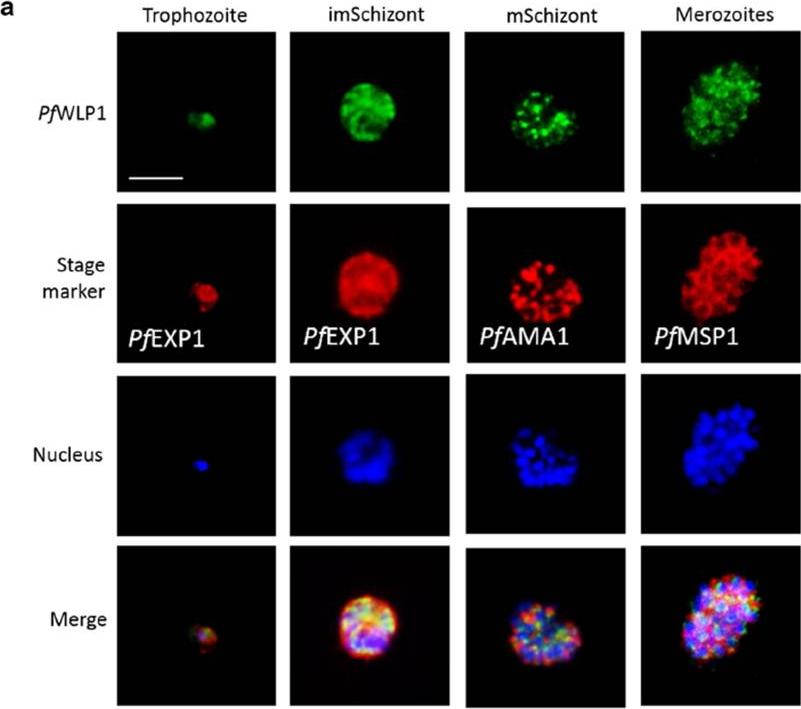PVX_118320 WD domain, G-beta repeat domain containing protein
Disruptability [+]
| Species | Disruptability | Reference | Submitter | |
|---|---|---|---|---|
| P. falciparum 3D7 |
Refractory |
26537493 | Theo Sanderson, Wellcome Trust Sanger Institute | |
| P. falciparum 3D7 |
Refractory |
USF piggyBac screen (Insert. mut.) | USF PiggyBac Screen | |
Mutant phenotypes [+]
| Species | Stage | Phenotype | Reference | Submitter |
|---|---|---|---|---|
| P. falciparum 3D7 | Gametocyte |
Attenuated |
35923798 (Knock down)
No effect seen on asexuals, but incomplete knockdown. \"In this study, we demonstrate that the presence of PfWLP1 is crucial for both the stability of these gametocyte-specific adhesion complexes as well as for gametocyte maturation and gametogenesis. Using reverse genetics, we generated a PfWLP1-knockdown parasite line for functional characterization of the protein. Knockdown of PfWLP1 resulted in a slight reduction of gametocyte numbers and significantly the impaired ability of the gametocytes to exflagellate. PfWLP1-knockdown further led to reduced protein levels of the Limulus coagulation factor C-like (LCCL)-domain proteins PfCCp1 and PfCCp2, which are key components of the adhesion complexes. These findings suggest that the interaction of PfWLP1 with members of the PfCCp-based adhesion complex ensures complex stability and thereby contributes to gametocyte viability and exflagellation.\" |
Theo Sanderson, Francis Crick Institute |
Imaging data (from Malaria Metabolic Pathways)

PfWLP1 is expressed in the asexual blood stages of Plasmodium falciparum. a Expression of PfWLP1 in the asexual blood stages. PfWLP1 was immunolabelled with anti-PfWLP1-rp2 antisera (green); the asexual blood stages were visualized with antisera against PfEXP1, PfAMA1 and PfMSP1 (red). The parasite nuclei were highlighted by Hoechst nuclear stain (blue). ImSchizont, immature schizont; mSchizont, mature schizont. Bar 5 μm. Data are representative of five independent experiments each.von Bohl A, Kuehn A, Simon N, Ngongang VN, Spehr M, Baumeister S, Przyborski JM, Fischer R, Pradel G. A WD40-repeat protein unique to malaria parasites associates with adhesion protein complexes and is crucial for blood stageprogeny. Malar J. 2015 Nov 4;14(1):435.
See original on MMP
PfWLP1 is expressed in the asexual blood stages of Plasmodium falciparum. Upper panel: Localization of PfWLP1 underneath the apical pole of merozoites. Image enlargements (right) of mature schizonts (left), labelled with antibodies against PfWLP1 (green) and PfMSP1 or PfAMA1 (red) and stained with Hoechst (blue). AP apical pole, N nucleus, MPM merozoite plasma membrane. Bar 5 μm. Data are representative of five independent experiments each. Lower panel: Expression of PfWLP1-HA in asexual blood stages. PfWLP1 expression in the PfWLP1-HA asexual blood stages. PfWLP1-HA was immunolabelled with anti-HA antisera (green); the asexual blood stages were visualized by Evans Blue counterstaining (red). The parasite nuclei were highlighted by Hoechst nuclear stain (blue),von Bohl A, Kuehn A, Simon N, Ngongang VN, Spehr M, Baumeister S, Przyborski JM, Fischer R, Pradel G. A WD40-repeat protein unique to malaria parasites associates with adhesion protein complexes and is crucial for blood stage progeny. Malar J. 2015 Nov 4;14(1):435.
See original on MMPMore information
| PlasmoDB | PVX_118320 |
| GeneDB | PVX_118320 |
| Malaria Metabolic Pathways | Localisation images Pathways mapped to |
| Previous ID(s) | Pv118320 |
| Orthologs | PBANKA_1307300 , PCHAS_1310500 , PF3D7_1443400 , PKNH_1238900 , PVP01_1263600 , PY17X_1311100 |
| Google Scholar | Search for all mentions of this gene |